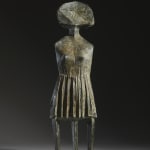 Lynn Chadwick, Skirt, 1970, Bronze, Edition of 6
Lynn Chadwick, Skirt, 1970, Bronze, Edition of 6
 Presentation of a dress during a Christian Dior fashion show 1950, © Roger Berson / Roger-Viollet
Presentation of a dress during a Christian Dior fashion show 1950, © Roger Berson / Roger-Viollet
 Left: Presentation of a dress during a Christian Dior fashion show 1950. © Roger Berson / Roger-Viollet
Right: Lynn Chadwick Skirt, 1970, Bronze, Edition of 6
Left: Presentation of a dress during a Christian Dior fashion show 1950. © Roger Berson / Roger-Viollet
Right: Lynn Chadwick Skirt, 1970, Bronze, Edition of 6
Alongside his wider interests, fashion photography also intrigued Chadwick. The body language of the models as well as how the shape of the clothes related to that body posture fascinated him. We believe several of the later sculptures were brought back from his subconscious as a result of seeing such photographs at a time when fashion itself was becoming bolder and more structural.
Certainly the Christian Dior fashion show at the Savoy Hotel in 1950 would have brought a spark of much needed glamour to Post War Britain during a time when rations were still the norm. At this show Dior proposed a number of stylistic ‘revelations’ across the collection of eighty dresses including bright colours for daywear and a front to back drop cut in the evening dresses. The cinched waist and A-line skirts were also the order of the day. Rungwe Kingdon adds:
Chadwick was at this time searching for a new way to tackle heads with his distinct method. This version, ‘Skirt’, one of the few to have a fully rounded head, owes much to his ‘Star’ and ‘Moon’ pieces. However he was soon to make the square and triangle heads that remained a signature part of his language for the rest of his life.



